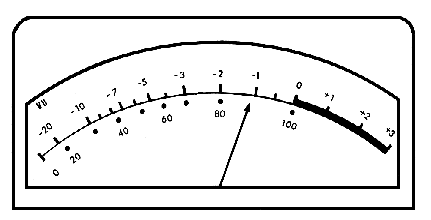
 |
VU Meter |
VU is an abbreviation for volume unit. Thus, a VU meter is a device for measuring the level of sound intensity with audio equipment, such as amplifiers and tape recorders.
Although the measurements indicated on such a meter are in decibels, the zero level should not be confused with 0 dB, the threshold of hearing. On such meters, zero indicates the maximum distortion-free level that can be handled by the device with other values greater or less than the zero level indicated as positive and negative decibels relative to it respectively. See: Zero Level VU.
In practice, analog devices have considerable headroom above 0 VU to allow for peak levels; digital recording systems, on the other hand, have little or no headroom because of their fixed dynamic range which is usually larger than with analog systems.
The diagram below shows a VU meter with a decibel scale from -20 to +3 dB, and a linear percentage of modulation scale from 0 to 100% below it. A meter which is linear in decibels (rather than percentage of modulation) is called a peak programme meter (PPM), and is commonly used in Britain.
Compare: Gain, Level Recorder, Oscilloscope, Signal-to-Noise Ratio, Sound Level Meter, Sound Pressure Level.

VU meter where levels above 0 VU are shown as positive decibels (the range of potential distortion), and those below it as negative decibels.